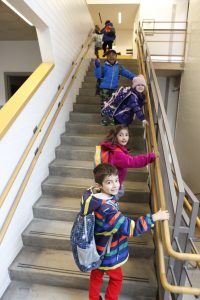 Imagine you are four years old, arriving at your new school – maybe your first school. Your mom or dad walks you down the tree-lined street to the front gate, where smiling adults you don’t yet know invite you in. You aren’t sure this is a good idea. You’d rather stay with your mom or dad. Your lip begins to tremble…
Imagine you are four years old, arriving at your new school – maybe your first school. Your mom or dad walks you down the tree-lined street to the front gate, where smiling adults you don’t yet know invite you in. You aren’t sure this is a good idea. You’d rather stay with your mom or dad. Your lip begins to tremble…
It is at this moment that the intentional design of the Early Childhood (EC) facility fulfills its true purpose: to teach the youngest Gaynor students how to calmly, safely, and thoughtfully make the transition from home to school.
According to Director of Early Childhood Rebecca Jurow, “When we designed the Early Childhood space, we paid particular attention to the emotional and organizational issues that all children, but especially children with learning differences, face. The staircase leading up to the second floor of the South Building embodies a particular philosophy.”
The rise on the stairs is shorter than a standard staircase, allowing for easy climbing. “All of the separation issues during morning drop-off are a challenge to begin with, so we made the stairs easier for little legs,” said Jurow.
Students arriving in the EC literally move to an entirely different level when they arrive in the morning. This supports the separation from parent and child to child and teacher.
Of course, the stairs themselves are merely a tool. The philosophy of the Early Childhood program requires careful implementation by Gaynor faculty and specialists. Each morning, the students are greeted at the bottom of the staircase by at least two specialists – usually an occupational therapist and a speech-language pathologist. Those specialists assist the student in the transition process, by helping them regulate their emotions as they leave their loved one for the day, or by making sure they have organized their belongings so that they can climb the stairs safely.
According to Jurow, “The spaces are vastly different, and students have to climb what seems like a mountain of stairs. We know that when kids move their bodies and exert that energy, they bring a different energy to what comes after it.” She continued, “We envision them entering as their parent’s child, and as they climb the stairs independently, they know they are now a Gaynor student. They experience a new level of independence that is different from what they may have experienced before and different from their experience with their caregivers.”
This article originally appeared in the Winter 2018 issue of Gaynor Gazette. View the full online issue here.
